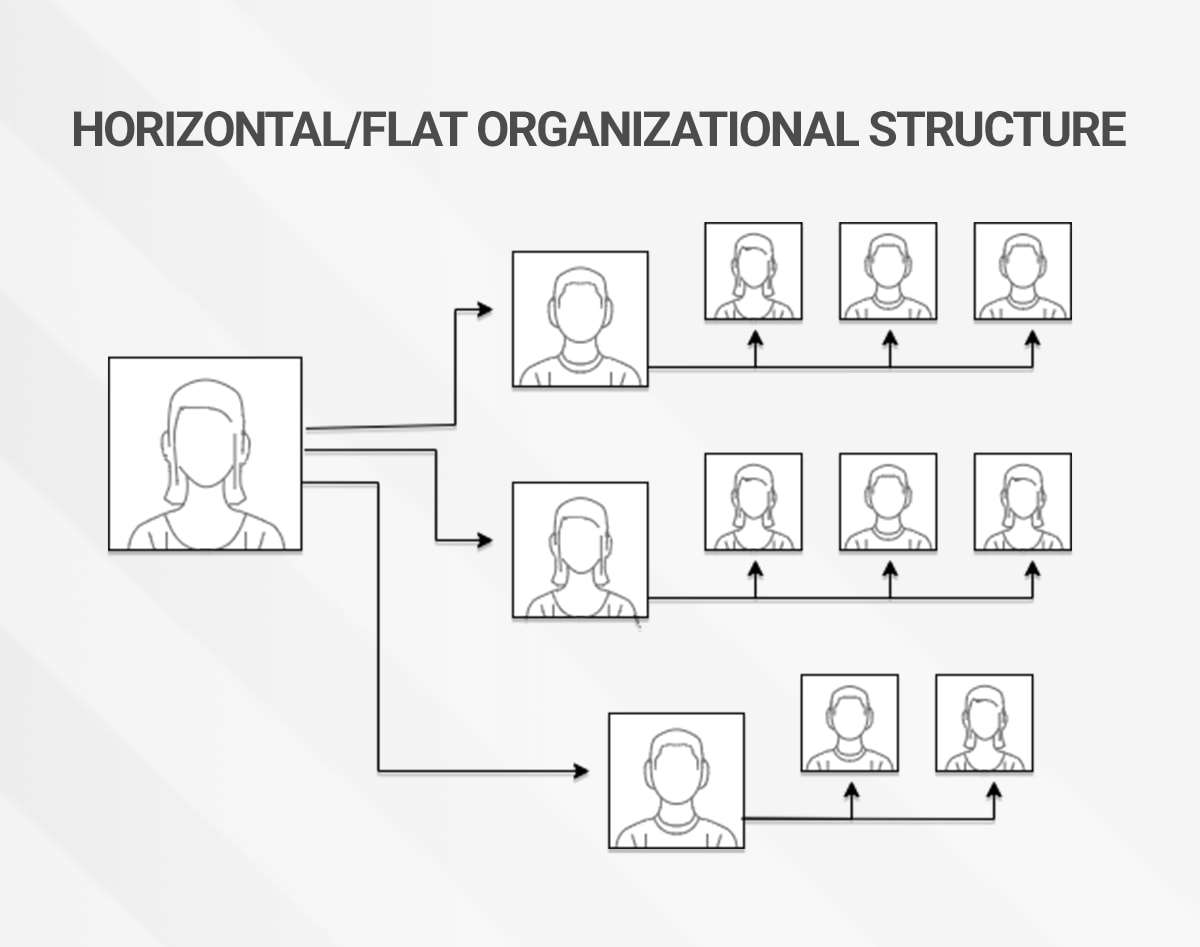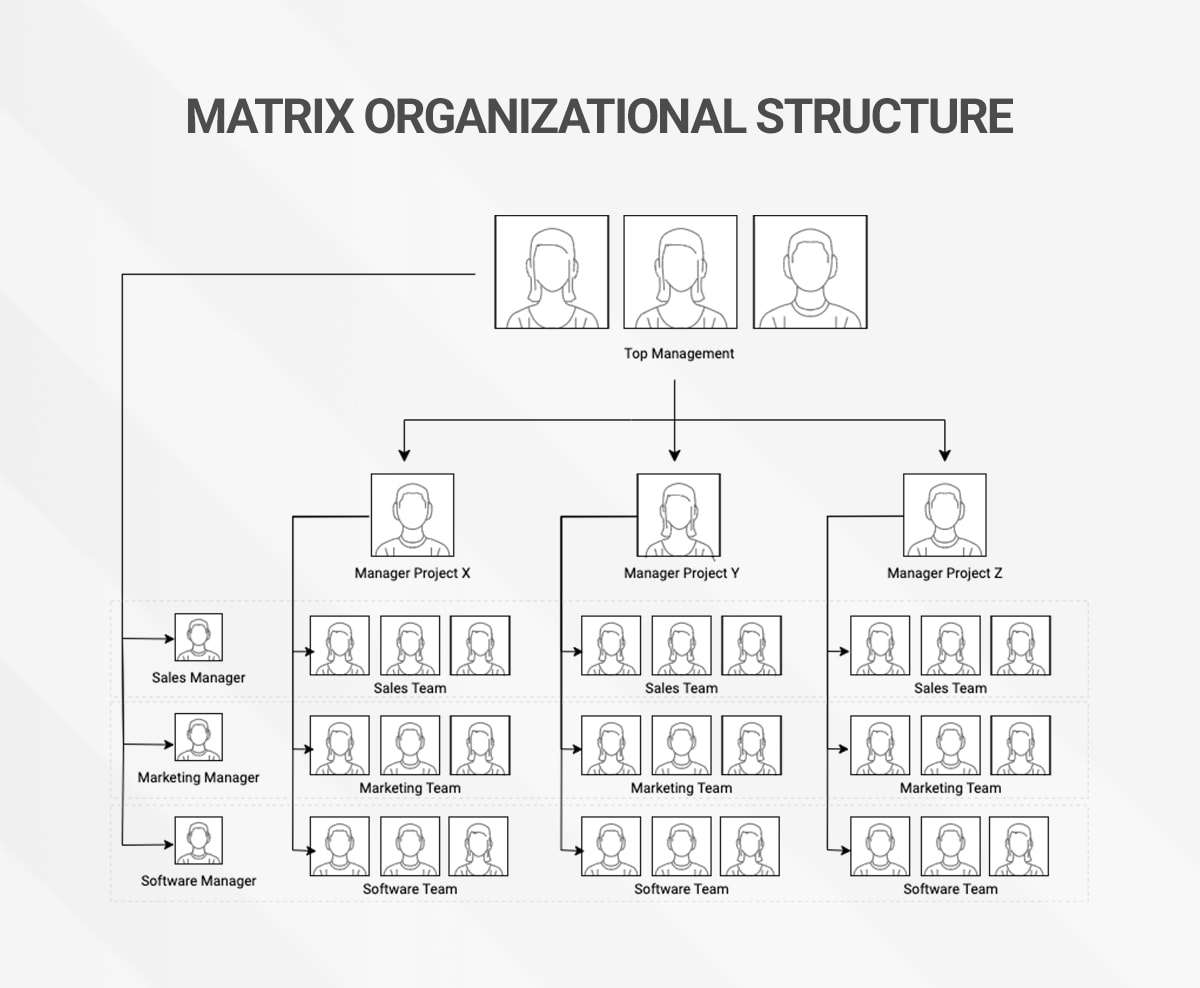Organization is key: This motto does not only ring true for most individuals, but is vital for any corporation. Organizational structures form the backbone of a functioning company and decide over success or failure. Whether you like it or not: If you do not choose your organizational structure wisely, it will choose you. Finding the perfect organizational structure type can be hard, which is why we provide you with an extensive overview of seven different organizational structures used by the world’s top-performing companies.
Organizational Structures: Defintition
First things first, let us find a definition for organizational structures within the corporate world. Basically, the organizational structure outlines how a company’s processes and employees are organized. It essentially is a system that determines how the company works, in order to achieve its overarching goals. This system determines employee’s areas of responsibility, to whom they report to and how decisions are made. In several case studies examples, such as those of the United Nations Handbook of Statistical Organization, these aspects are non-negotiable if a company wants to be successful in the long run.
There is not one universal organizational structure that is suitable for every company. Different organizational structures are just as unique as any corporation, and require a lot of planning and implementation time to perfect. However, there are certain aspects every individual company should take into consideration before deciding on the structure of their company, such as:
- The company’s size and future expansion plans
- The market situation: Is it ever-changing or consistent? Are there regionally-specific differences?
- Company goals
- The way and intensity employees work together
- Product diversity
- Meeting styles and types
Why Organizational Structure Types are important
Humans are innately partial to structure, which becomes clear when looking at our evolutionary history. For our early ancestors, small groups were necessary for providing resources and sharing responsibilities. They were also vital to achieve sustainable competitive advantages over predators and rivals. As populations grew and our societies transformed, different organizational structures emerged. Small family groups turned into villages, cities, states as well as companies and corporations. Our organizational systems are ever-changing and each comes with advantages as well as disadvantages.
Looking at it from the perspective of a corporation, an overarching organizational structure defines the hierarchies, chains-of-command, responsibilities as well as the pay structures of everyone involved. Poor structure, or the lack thereof, may lead to miscommunication, work delays and low morale.
Different Organizational Structures: Centralization and departmentation
Before comparing different organizational structures, we need to decide on the defining factors each structure entails. There are a myriad of features within each organizational structure. In our definitions, we decided to compare the level of centralization as well as departmentation.
Centralization looks at how the decision-making power within a company is distributed. Within centralized structures, decisions are made at the top level of the hierarchy by one or a few key managers. Here, the chain of command is clearly hierarchical. In decentralized structures, decision-making involves more parties and happens autonomously within the different teams of an organization.
The second aspect, departmentation, describes the processes of grouping specific tasks and activities into departments within a corporation. Departments are usually linked to functional, geographical, product- or customer-orientated aspects. The best known types of departments include areas such as sales, finance or marketing. In which way a company makes use of departments influences communication, coordination and decision-making processes.
| Hierarchical | Functional Structures | Flat | Divisional | Matrix Structures | Team-based | Network | |
|---|---|---|---|---|---|---|---|
| Chain of command | Central | Central | Decentral | Central | Central/Decentral | Decentral | Decentral |
| Cross-divisional work? |
1. Hierarchical Organizational Structure Definition
Let’s start our journey with discussing one of the most well-known organizational structures, namely the hierarchical structure. This model is well established throughout corporations of all shapes and sizes. In a hierarchical structure, the hierarchical power is clearly defined and the lines of authority and communication are very straight-forward. This is similar to the functional structure, which we will discuss in the next section.
There are many prime examples of hierarchical structures in use. One of the most noteworthy is Amazon’s structure. As the company currently employs around 560,000 people across the globe, it makes Amazon the biggest online retailer in the world. The company is divided into distinct departments such as software, HR, finance and business operations. Decisions are exclusively made by the management team, especially the CEO.
Centralization
The chain of command ranges from the top executive with the highest decision-making power down to the regular employees. Communication is arranged from the top-down, making the hierarchical model centralized. If one were to portray hierarchical structures in a matrix, it would resemble a pyramid, with the most senior position being at the very top. Therefore, the hierarchical model is a centralized organizational structure.
Departmentation
Most hierarchical structures favor the use of departments, in order to divide employees into groups according to their tasks and functions. There are usually several levels of management that each has a clear set of responsibilities and decision-making power. When the responsibilities of every party involved are straightforward, which is the case when clear hierarchies are involved, operations can run efficiently and smoothly.
| Advantages: | Disadvantages: |
|
|
2. Functional Organizational Structure Definition
The functional organizational structure is also one of the most common organizational structures, similar to the hierarchical model. It is also known as the bureaucratic organizational structure. This structure groups the workforce together according to the field of specialization of the employees, so their respective job functions. Companies working with this type of structure tend to divide their firm into distinct departments, such as marketing, sales and operations. Cooperation between different departments is usually limited.
This structure is very popular, especially within larger organizations, since it encourages stability and steady work processes. The company Airtel, which is one of the leading telecommunication companies in India, is also using ta functional structure to organize their workforce.
Centralization
Within a functional organizational structure, the hierarchy creates scales of power. Similar to hierarchical structures, those that have the most decision-making powers are at the top, while the rest are at the bottom of the hierarchy. Power flows from the top down. Decision-making is done by few individuals only. Therefore, bureaucratic structures count as a centralized organizational structure.
Departmentation
As the name suggests, functional companies divide employees into departments according to their functions. These departments are usually made up of the typical divisions such as sales, marketing, HR, finance, production and so on, as well as a management team.
| Advantages: | Disadvantages: |
|
|
3. Horizontal or Flat Organizational Structure Definition
Flat organizational structures are frequently used by startups or smaller corporations. However, many big conglomerates have also picked up on the advantages of this structure and now use it themselves. The structure is characterized by eye-to-eye communication, agility, flexibility and a well distributed decision-making power. Leading companies such as Facebook, General Electric and Gore utilize a flat organizational structure in order to succeed.
Centralization
One of the most striking characteristics of flat or horizontal structures is, that they operate on a decentralized level. Flat organizations actively encourage all their employees to make decisions and further shape the development of the company. The levels of management do not autonomously operate as the only decision-making power. At the same time, management puts trust in their employees and executes less rigid supervision than in other structures.
Departmentation
To what extent flat organizations make use of departments, can look very differently across the board. Employees may work together according to product, department or localization. In a flat organization, cooperation between departments is encouraged. Employees may also work cross-divsionally on projects that have nothing to do with any particular department at all.
| Advantages: | Disadvantages: |
|
|
4. Divisional (or Multidivisional) Organizational Structure Definition
A divisional or multidivisional structure is a great example of a decentralized organizational model. Big corporations in particular often operate within many different business units. These business units operate autonomously and have control over their own resources. Essentially, the units form their own companies within a larger organization. Divisional corporations can either be
- Market-based: The different divisions are separated by the market they are operating in. The company focuses around markets, industries or types of costumers.
- Product-based: The divisions are separated by specific product lines.
- Location-based: Divisions are separated by regions or districts. This way, the company can more effectively cater their products or services to a specific region or country.
Take the fast food chain McDonald’s as an example, which is one of the best known companies in the world. Due to its fragmentation around the world, the company has started out with a geographical divisional structure.
Another example is Pepsi, which operates as a parent company for several daughter-brands, and consequently uses a divisional structure based on product and geography.
Centralization
Since divisions tend to look after their resources and tasks independently, this type of company structure is decentralized. Power is not induced from the CEO down, but happens separately within every division. Individual departments have autonomy and room for innovation.
Departmentation
In this structure, there still may be overarching departments such as finance, sales, or HR. Within the respective divisions, at least one member of every department is usually present. Example: Each division can have its own marketing, sales or finance team. So employees usually have two managers. Firstly, the product manager, who is in charge of the product or service the division is in charge of. And secondly, a manager overseeing the employees within a department, that work across the different divisions.
| Advantages: | Disadvantages: |
|
|
5. Matrix Organizational Structure Definition
In comparison to other structures, matrix organizational structures tend to be used less often. This type of structure is deemed confusing and complicated by many organizations. Essentially, a matrix structure is a blend of two (or more) other organizational structures, usually a functional and divisional structure.
In a matrix structure, cross-functional teams come together for special projects. Employees may have a double-role, as a sales person working on a specific project and a member of the marketing team, for example. This means, that there are several overlapping divisions and reporting schemes within the organization. This makes sense for large corporations with a global presence. When juggling various projects at the same time, structure needs to be flexible and efficient.
Successful companies such as Starbucks utilize a matrix structure for their everyday work. The organization combines several functional as well as product-based divisions, leading to overlapping reporting structures.
Centralization
As is becoming clear, this type of structure demands some careful planning. Matrix structures form a hybrid of centralized and decentralized organizations. Within the functional departments, there is usually a top-down hierarchy. Within the cross-functional product teams, however, employees are responsible for making their own decisions.
Departmentation
Employees are supervised within their departments and do their everyday work. However, they also come together in order to work on projects cross-divisionally, that do not have anything to do with their departments and are not overseen by their department manager.
| Advantages: | Disadvantages: |
|
|
6. Team-Based Organizational Structure Definition
Team-based organizations operate similarly to divisional ones. Employees operate in close-knit teams working towards common goals and functions. Each team contains managers and employees from different fields. The teams are either customer-, product-, market– or mission-focused. The individual decisions are made according to the overall business plan of the company. The difference to divisional structures is, that employees do not necessarily remain within the same static configuration forever, but rather move from team to team.
One of the first occurrences of this structure was executed by the US military, which felt like the previous hierarchical dynamic hindered operational successes during several war endeavors. Dividing power into agile teams allowed for better and faster communication, which made it easier to attain important real-time information n the enemy’s activities. However, it did not take long for corporations to realize the potential in this structure and adapt it to business models.
Centralization
Decision-making within team-based structures is less hierarchical and operates, therefore, in a decentralized style. Decisions are oriented on the overarching goals of the company, but tend to be made by the employees themselves.
Departmentation
Similarly to matrix structures, these corporations operate within departments, to which employees can “return to” when they are between projects. These departments have overarching managers, such as a Chief Financial Officer within the finance department. Within the department, employees are divided into teams with team managers and other team members.
| Advantages: | Disadvantages: |
|
|
7. Network Organizational Structure Definition
Depending on the type and size of an organization, companies may need to outsource some of their services. Within a network structure, third-party vendors, contractors and freelancers can carry out certain key functions. Such partnerships can also form for special projects the organization is carrying out and, therefore, be a temporary solution. Network structures usually have a core company or team, which is consistent throughout the outsourcing process.
The clothing-company Hennes & Mauritz makes use of this particular structure. In this case, the H&M team forms the core company. They have outsourced the production of their goods to different countries, for example Asia, where production prices are generally cheaper than in Europe or other parts of the world. Their product development team is currently situated in Australia, while the call center division operates out of New Zealand.
Centralization
Managers control the internal and external working processes within a network structure. However, the power structure within the core team tends to be less hierarchical, since many functions are passed on to the partner organizations. The span of control is generally wider, making it a decentralized structure.
Departmentation
Having a multitude of departments is less prominent within network structures, since many of the classic departments are performed by the partner organizations. The core team focuses on the main mission of the corporation. Headquarters tend to be smaller, while the company has several hubs, that are connected to the core team virtually.
| Advantages: | Disadvantages: |
|
|
Can the organizational structure undergo changes?
Having investigated these seven different types of organizational structures, you may conclude with the question: Which of these structures is the best fit for my company? The answer to this is beyond the scope of any article. If your existing structure is the best fit for your company, requires a lot of analysis, awareness, as well as trial and error.
The good news is, that organizational structures are by no means static, but can change as your company evolves and grows. In fact, according to a Gartner study, organizations worldwide have gone through five structural shifts on average over the past three years. Many of these changes fail, which is why it is so important to not only take structural but also cultural shifts into account.
We get it: Fundamentally changing your organization can be beyond daunting. We are also currently in the process of a big structural change, and can confirm that it comes with countless challenges and hurdles. However, setting sail with our new and improved teamazing-fleet has been worth the process. When will you take control over your organizational structure and change your team for the better? If you are interested in change on a team level, take a look at our guide to team development.










